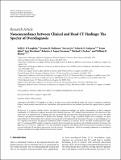| dc.contributor.author | O'Laughlin, Kelli N. | en_US |
| dc.contributor.author | Hoffman, Jerome R. | en_US |
| dc.contributor.author | Go, Steven | en_US |
| dc.contributor.author | Gabayan, Gelareh Z. | en_US |
| dc.contributor.author | Iqbal, Erum | en_US |
| dc.contributor.author | Merchant, Guy | en_US |
| dc.contributor.author | Lopez-Freeman, Roberto A. | en_US |
| dc.contributor.author | Zucker, Michael I. | en_US |
| dc.contributor.author | Mower, William R. | en_US |
| dc.date.accessioned | 2014-03-11T02:49:37Z | |
| dc.date.issued | 2013 | en_US |
| dc.identifier.citation | O'Laughlin, Kelli N., Jerome R. Hoffman, Steven Go, Gelareh Z. Gabayan, Erum Iqbal, Guy Merchant, Roberto A. Lopez-Freeman, Michael I. Zucker, and William R. Mower. 2013. “Nonconcordance between Clinical and Head CT Findings: The Specter of Overdiagnosis.” Emergency Medicine International 2013 (1): 314948. doi:10.1155/2013/314948. http://dx.doi.org/10.1155/2013/314948. | en |
| dc.identifier.issn | 2090-2840 | en |
| dc.identifier.uri | http://nrs.harvard.edu/urn-3:HUL.InstRepos:11879151 | |
| dc.description.abstract | Background:. It is unclear whether history and physical examination findings can predict abnormalities on head computed tomography (CT) believed to indicate increased risk of lumbar-puncture- (LP-) induced brain herniation. The objectives of this study were to (1) identify head CT findings felt to be associated with increased risk of brain herniation and (2) to assess the ability of history and physical examination to predict those findings. Methods:. Using a modified Delphi survey technique, an expert panel defined CT abnormalities felt to predict increased risk of LP-induced brain herniation. Presence of such findings on CT was compared with history and physical examination (H&P) variables in 47 patients. Results:. No H&P variable predicted “high-risk” CT; combining H&P variables to improve sensitivity led to extremely low specificity and still failed to identify all patients with high-risk CT. Conclusions:. “High-risk” CT is not uncommon in patients with clinical characteristics known to predict an absence of actual risk from LP, and thus it may not be clinically relevant. “Overdiagnosis” will be increasingly problematic as technological advances identify increasingly subtle deviations from “normal.” | en |
| dc.language.iso | en_US | en |
| dc.publisher | Hindawi Publishing Corporation | en |
| dc.relation.isversionof | doi:10.1155/2013/314948 | en |
| dc.relation.hasversion | http://www.ncbi.nlm.nih.gov/pmc/articles/PMC3803127/pdf/ | en |
| dash.license | LAA | en_US |
| dc.title | Nonconcordance between Clinical and Head CT Findings: The Specter of Overdiagnosis | en |
| dc.type | Journal Article | en_US |
| dc.description.version | Version of Record | en |
| dc.relation.journal | Emergency Medicine International | en |
| dash.depositing.author | O'Laughlin, Kelli N. | en_US |
| dc.date.available | 2014-03-11T02:49:37Z | |
| dc.identifier.doi | 10.1155/2013/314948 | * |
| dash.contributor.affiliated | O'Laughlin, Kelli | |


